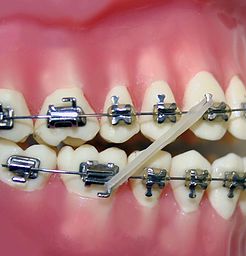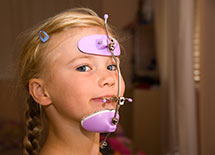Rapid Palatal Expander | Herbst | Elastics | Retainers | Headgear
 Rapid Palatal Expander
Rapid Palatal Expander
The Rapid Palatal Expander (RPE) is a special appliance (usually attached with bands) that widens the roof of your mouth by putting gentle pressure on your upper molars each time an adjustment is made.
Why is this appliance sometimes necessary?
The RPE expands the upper jaw, so that the upper and lower jaw are in harmony. The RPE also creates space for crowded teeth.
How long will treatment take?
It usually takes about 4 to 6 weeks to achieve expansion. You will wear the appliance for a total of 5-7 months so that new bone can generate in your expanded jaw.
Will I feel the appliance moving?
Initially, you may feel some discomfort and pressure, causing a tingling sensation or itching under the appliance. You may also feel a tingling sensation on the bridge of your nose. Do not be alarmed if you see a space between your two front teeth. This is only temporary. The space will eventually close naturally, or we may close it with braces.
What should I do during the expansion phase?
Gently brush around the appliance. Rinse with Listerine to treat irritation and keep your mouth free of food particles. Take pain medicine to alleviate any discomfort.
How is the RPE activated?
Once Dr. Adams has cemented the RPE, it is the parent who will activate it. This is done AT LEAST ONCE EACH DAY, depending on the doctor's instructions (frequency of turns will vary for each individual patient). Your parents must activate the appliance according to Dr. Adams instructions. It is much easier to have your parent do it (than yourself) by having you lay your head in his/her lap. Lean your head back so your parent can see the top of your mouth. Next, insert the key gently into the hole or slot in the middle front portion of the appliance. Push the key carefully and gradually from the front toward the back of your mouth. The key will swivel in a circle. Remember do not back up. The key moves toward the throat. As it rotates, when you push the key as far back as possible, a new key hold position will automatically come forward. Gently wiggle the key towards the throat until it comes out of the hole. Keep the key in a safe place until the next day.
 Herbst
Herbst
What does it do?
One of the most common problems orthodontists treat is the discrepancy that occurs when the upper teeth protrude beyond the lower. Ordinarily, when we see a patient with the upper teeth protruding, we tend to think that the upper jaw and teeth are too far forward; but, more often than not, this condition is due to a small lower jaw that is further back than it should be. The Herbst appliance is designed to encourage the lower jaw to catch up in growth. It helps the lower jaw to develop in a forward direction. At the same time the Herbst is used to place pressure on the upper jaw in a backward direction. Expansion may also be achieved in the upper jaw if desired (see Rapid Palatal Expander).
How does it work?
Similar to a shock absorber, a tube and rod work together to connect the upper and lower jaws. This does not restrict eating or affect the closing and opening of the mouth. However, the Herbst appliance does slightly hinder side to side movement.
What will I expect to feel?
Initially, your may experience tenderness in the teeth, the area near the jaw joints, and also in the cheek muscles. This feeling is normal and will go away within a week. If you continue to have tenderness after a week, contact us. Rinsing with warm salt water may also help. If there is any discomfort, use Advil or Ibuprofen. The appliance may irritate the insides of your cheeks until you get used to it. You may find it easier to sleep on your back so there is not much pressure to the cheeks.
What if it breaks?
If the rod happens to slide out of the tube when you open your mouth, open wide again and guide the rod back in the tube while closing. Save all the pieces of the screw and/or crown if they come loose. Call us to schedule a repair appointment.
To prevent breakage, DO NOT EAT:
- Popcorn
- Ice
- Chewing Gum
- Sticky Foods
- Hard Foods (such as nuts and candies)
How long will it be in my mouth?
Typically, the Herbst appliance is left in place for about 12 months. During this time, we will place braces on your front teeth. When the Herbst is removed, additional braces will be put on the back teeth so we can complete your treatment.
 Elastics
Elastics
During treatment you may be required to wear elastics (rubber bands) of various sizes on your braces. Elastics are an important part of treatment. Success depends upon your cooperation.
Why are elastics used?
Elastics add extra pressure to braces to help with tooth movement. For instance, if the lower teeth are too far back and the upper teeth are too far forward, elastics may be placed from the upper front teeth to the lower back teeth.
Why are elastics important?
Elastics must be worn in order to achieve optimum treatment results. Wearing elastics can be difficult because they are not comfortable. However, patient compliance is very important to prevent a delay in treatment.
If you wear elastics one day but do not wear them the next day, your teeth will set up a resistance that may prolong or stop treatment, and also cause more discomfort. If they are worn one week, but not the next week, your teeth may move back to their original position.
Retainers
Congratulations! Today you will begin an essential phase in your treatment, known as RETENTION. Your teeth have moved significantly over the past few months, but are not firmly fixed in place. You will wear retainers to ensure your teeth stay in their new positions until they are stable. The retention phase will last 1-2 years, however ideally retainers should be worn indefinitely. We suggest that you sleep in your retainer every night for life to prevent shifting.
 Retainers help keep your teeth in their new corrected positions. Please follow these guidelines carefully:
Retainers help keep your teeth in their new corrected positions. Please follow these guidelines carefully:
- Soreness will subside in a few days, even following an adjustment appointment. If you notice that a particular area is sore after 3 or 4 days, contact the office to schedule an appointment.
- Avoid flipping the retainer with your tongue. This may damage your teeth.
- You may notice the retainer has a plastic taste. Fortunately, this will disappear quickly. Your speech should return to normal within a few days of wearing the retainer.
- Clean your retainer by using PLAX or RETAINER BRITE (1-800-866-6884) or you can use denture cleaner to clean it. DO NOT use toothpaste to clean your retainer. If you don't clean the retainer regularly, a hard deposit will build up on the surface, which can cause gum irritation. .
- Remember to always bring your retainer to every appointment.
- Keep your retainer in a special case when you are not wearing it. Do not put in in your pocket or wrap it in a napkin. Someone may think it is trash and throw it away. The case prevents accidental damage to the retainer.
- Always keep your retainer away from your pets.
- Retainers can break, so handle them with care. If you break or lose your retainer, call us immediately.
- Keep your retainer away from heat sources. Heat could cause them to warp.
 We use three types of retainers in our office. Each has advantages and disadvantages over the others. Dr. Adams will decide which type of retainer is right for you.
We use three types of retainers in our office. Each has advantages and disadvantages over the others. Dr. Adams will decide which type of retainer is right for you.
- Essix Retainers - these retainers are formed from heat and should not be boiled or put in hot places like your car in the summertime.
- Fixed Retainers - these are small wires attached to the back of the upper and lower front teeth. Fixed retainers keep your teeth in their corrected positions. They require special attention! Be sure to floss regularly and avoid hard foods.
- Wire Retainers (Hawley retainers) - these should be worn 24 hours a day for the first 3 months (except during meals and brushing) unless Dr. Adams gives you other instructions. Later, you will wear your retainer at night while you sleep.
 Headgear
Headgear
Headgear is often used to correct an excessive overbite. This is done by placing pressure against the upper teeth and jaw, which would hold the teeth in position or help move them into better positions. The severity of the problem determines the length of time headgear needs to be worn. The key to success with your headgear appliance is consistency. Headgear must be worn a certain number of hours per day, and if not, it must be made up the following day. Headgear should never be worn while playing sports and should also be removed while eating or brushing your teeth.

